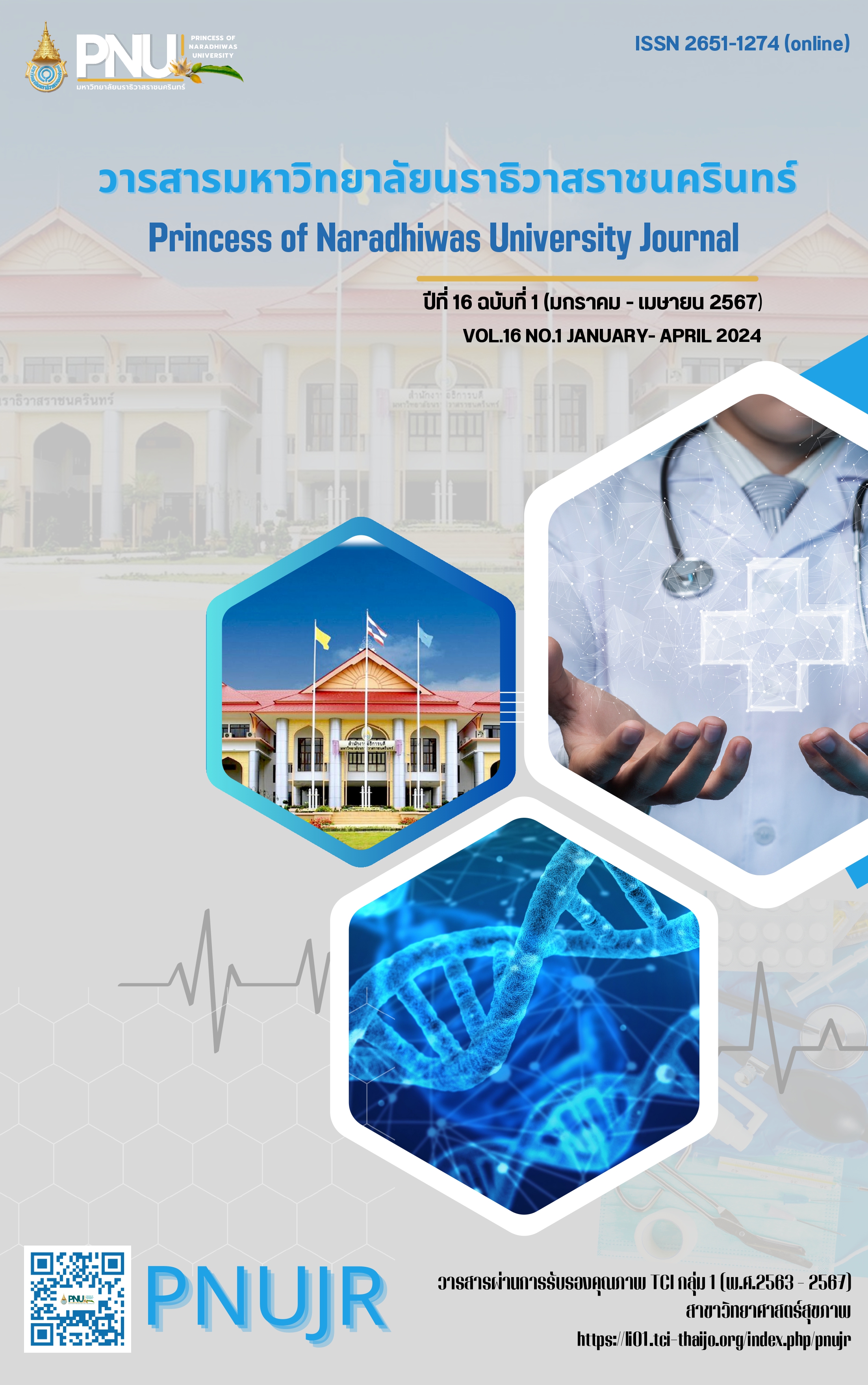Factors Predicting Coronavirus Disease 2019 Prevention Practices among Patients Receiving Services at the Respiratory Infection Clinic, a Community Hospital
Jeeraporn Pooreeya
Keywords:
Factors Predicting, Coronavirus Disease 2019 Prevention, Patients the Respiratory Infection Clinic, Health Beliefs model, Infection preventionAbstract
This predictive research aimed to study the predictive factors of COVID-19 prevention practices among patients attending infectious disease clinics respiratory system in a community hospital. The data was conducted from March 2021 to March 2022. The sample (n = 347) were the patients who received services at a respiratory infectious disease clinic in a community hospital in the southern region using purposive sampling. Research instruments included the Health Belief Questionnaire for COVID-19 and the COVID-19 Prevention Behavior Questionnaire 2019. Both instruments were tested the content validity by 6 experts and the content validity index of the instruments were 0.97, and 0.82, respectively. In internal consistency of both instruments were 0.75, and 0.72, respectively. Data were analyzed by descriptive statistics and stepwise multiple regression analysis.
The results showed that the COVID-19 prevention behavior was at a high level ( ± S.D. = 102.00 ± 4.93). The perceived risks, the perceived severity of the disease, the perceived benefits of the treatment and prevention, the perceived barriers, and cue to practice action were all at a high level with a mean score and standard deviation of 19.11 (S.D. ± 1.87), 44.93 (S.D. ± 3.65), 22.36 (S.D. ± 1.94), 14.88. (S.D. ± 2.17), 44.37 (S.D. ± 3.35), respectively. The perceived benefits of the treatment and prevention (ß = .92, p. < 0.05) and the perceived severity of the disease (ß = .36, p. < 0.05) were only the factors that could predict the COVID-19 prevention behavior and could explain 52.5 %
(P< 0.05, R2 = .525) of variation of the prevention behavior.
The most important one which can lead to improving the COVID - 19 prevention practices among patients attending infectious disease clinics respiratory system in a community hospital.
References
Charoenchan, T., & Surinya, T. (2014). beliefs in health. perceived self-efficacy, parenting style and self-care behaviors of high school students at satri nonthaburi school nonthaburi province. Journal of Social Sciences and Humanities, 40(1), 69-84.
Department of Disease Control, Ministry of Public Health. (2020). Situation Report of Coronavirus Disease 2019. Retrieved January 20, 2022 from https://ddc.moph.go.th/viralpneum onia/situation.php
European Centre for Disease Prevention and Control. (2020). Q&A on COVID-19: Basic facts. Retrieved January 20, 2022 from https://www.ecdc.europa.eu/en/covid-19/facts/questions-answers-basic-facts
Kaewpoka, N. (2018). Health Perceptions Associated with Hypertension Prevention Behaviors of People in Yannawa Subdistrict, Sathorn District, Bangkok. Public Health Journal, 19, 47 - 60.
Khantichitr, P., Promwong, W., Keawmanee, C., & Charoenukul, A. (2021). Health Belief Model in the Prevention of Corona Virus Disease 2019 (COVID-19) among people in Ubon Ratchathani Province. Journal of health sciences Boromarajonani College of Nursing Sunpasitthiprasong, 5(2), 39 - 53.
Kubik, V., Jönsson, F.U., Knopf, M., & Mack, W. (2018). the direct testing effect is pervasive in action memory: analyses of recall accuracy and recall speed. Frontiers in psychology, 9, 1632.
Maiman, L.A., & Becker, M.H. (1974). The Health Belief Model: Origins and Correlates in Psychological Theory. Health Education & Behavior, 2(4), 336 - 353.
Narathiwat Provincial Public Health office. (2021). COVID-19 epidemic situation in Narathiwat province. Retrieved January 20, 2022 from http://drp.ntwo.moph.go.th/dashboard-nwt/
Ozili, P.K., & Arun, T. (2020). Spillover of COVID-19: impact on the global economy. Retrieved January 28, 2022 from https://papers.ssrn.com/sol3/papers.cfm?abstract_ id=3562570#paper-citations-widget
Polit, D.F., & Beck, C.T. (2008) Nursing Research: Generating and Assessing Evidence for Nursing Practice. (8th Ed.) Philadelphia: Wolters Kluwer Health/Lippincott Williams & Wilkins.
Quigley, A.L., Stone, H., Nguyen, P.Y., Chughtai, A.A., & MacIntyre, C.R. (2020). Estimating the burden of COVID-19 on the Australian healthcare workers and health system during the first six months of the pandemic. International Journal of Nursing Studies, 121.
DOI: 10.1016/j.ijnurstu. 2020.103811.
Rosenstock, I.M. (1974). historical origins of the health belief model. Health Education & Behavior, 2(4), 328 - 335.
Rungnoey, N., Ditbanjong, P., Klomhom, P., Krudakart, S., & Getthong, N. (2022). Factors Predicting Monitoring and Preventive Behaviors of COVID - 19 among Nursing Students. Princess of Naradhiwas University Journal, 14(2), 17 - 37.
Shaukat, N., Ali, D.M., & Razzak, J. (2020). Physical and mental health impacts of COVID-19 on healthcare workers: A scoping review. International Journal of Emergency Medicine, 13(1), 1 - 8.
Suthipatangkun, C. (2015). Predictive factors for coronary heart disease prevention behavior among university personnel in supervision. State of Bangkok. Master of Nursing Thesis, Chulalongkorn University Bangkok. (in Thai).
Srisathinarakun, B. (2010). Nursing research methods (5th ed.) printing. U & I Intermedia. (in Thai).
Taearak, P. (Editor). (2020). Guidelines for Organizing a Consultation Circle to Unite Energetic CitizensHelping the nation fight against COVID-19 Quality of life recovery period. Retrieved January 26, 2022 from http://www.nakhonpathom.go.th/files/com_news_report/2020-07_cb1c5d16694ea75.pdf
Torales, J., O’Higgins, M., Castaldelli-Maia, J.M., & Ventriglio, A. (2020). The outbreak of
COVID - 19 coronavirus and its impact on global mental health. International Journal of Social Psychiatry, 66(4), 317 - 340. DOI: 10.1177/0020764020915212
Weehayi, H. (2020). Violence perceptions and preventive behaviors for coronavirus Disease 2019 (COVID-19) of adolescents in sateng nok subdistrict, mueang district, yala province. Journal of Community Public Health, 6(4), 158 - 168.
Wong, L.P., Alias, H., Wong, P.F., Lee, H.Y., & AbuBakar, S. (2010). The use of the health belief model to assess predictors of intent to receive the COVID-19 vaccine and willingness to pay. human vaccines & immunotherapeutics, 16(9), 2204 – 2214.
World Health Organization. (2020). Advice on the use of masks in the context of COVID-19. Retrieved January 28, 2022 from https://www.who.int/publications/i/item/advice-on-the-use-of-masks-in-the-community-during-home-care-and-in-healthcare-settings-in-the-context-of-the-novel-coronavirus- (2019-ncov)-outbreak.
Worathanarat, P. (2020). 3 Major impacts of COVID-19 on Thai people's health. Retrieved January 28, 2022 from https://www.isranews.org/article/isranews-article/88562-covid-32.html.
Downloads
Published
How to Cite
Issue
Section
License
Copyright (c) 2023 Princess of Naradhiwas University Journal

This work is licensed under a Creative Commons Attribution-NonCommercial-NoDerivatives 4.0 International License.




